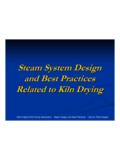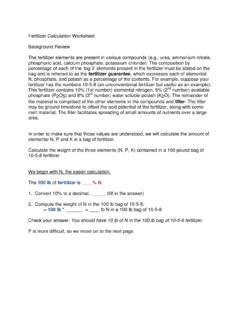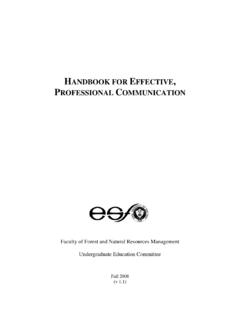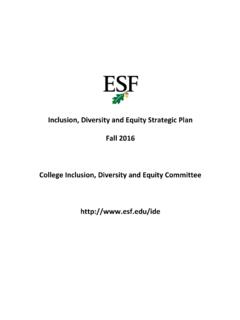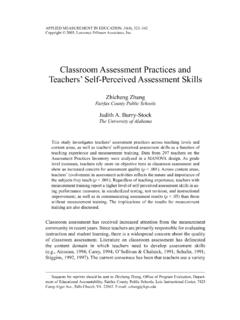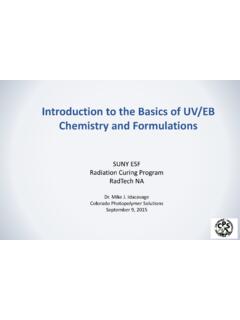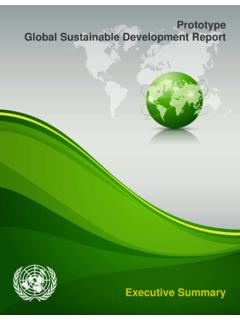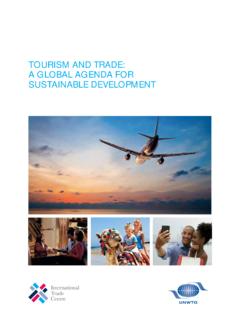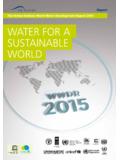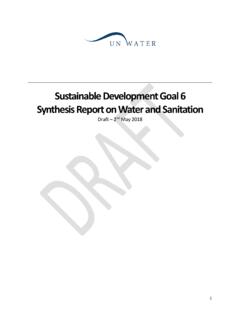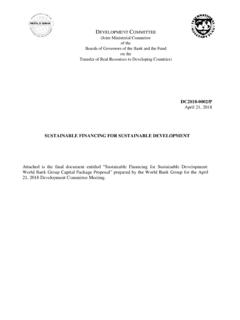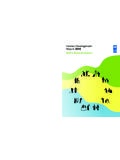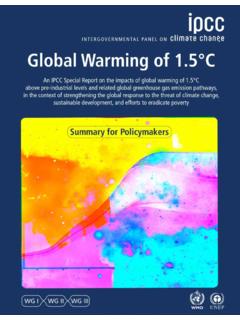Transcription of Assessing Sustainable Development for the 2014‐15 UN ...
1 Assessing Sustainable Development for the 2014 15 UN global Sustainable Development report 2013 Project Members SUNY-ESF students WUR students Annisa Dian Pratiwi Carmen Chan Chao Jiang Giulia Bongiorno Cherry Ignacio Jasmijn Appels Lina Camargo Katja Kuivanen Nargis Artyushevskaya Nik Buijze Rakhshinda Bano Rogier Justin Reemer Whitney Forman-Cook Stan Willems Commissioners and Affiliation: R.
2 Alexander Roehrl and David O Connor Division for Sustainable Development (DSD), United Nations Department of Economic and Social Affairs (UN DESA) Project Duration: August-December 2013 Disclaimer: This report was produced by students of Wageningen University (WUR) and State University of New York College of Environmental Science and Forestry (SUNY-ESF). It is not an official publication and the content herein does not represent any formal position or representation of WUR or SUNY-ESF. Executive Summary ..The core values that underpin Sustainable Development - interdependence, empathy, equity, personal responsibility and intergenerational justice - are the only foundation upon which any viable vision of a better world can possibly be constructed . From: "Capitalism - as if the world matters" by Jonathon Porritt, environmentalist and writer (2005). Sustainable Development is a challenging concept since it encompasses so many different things.
3 It is meant to combine social progress, economic Development and environmental responsibility by focusing on people, planet and profit. It is a common understanding that people nowadays live longer, and that the global population is rising. It is expected that by the year 2100 there will be over 10 billion people living on the planet. This significant increase is perhaps one of the most important reasons why Sustainable Development is so important. This report gives the outcome of the project titled Assessing Sustainable Development for the United Nations global Sustainable Development report . The report intends to reflect on a wide range of perspectives on Sustainable Development , both in terms of different scientific communities and the political level of decision making. It aims to be a contribution in the preparation for the second global Sustainable Development report (GSDR), prepared by the Division for Sustainable Development (DSD) of the United Nations Department for Economic and Social Affairs (UN DESA).
4 The report includes two main sections: Policy Briefs and Science Digests. The first aims to map some of the major global and cross-sector scientific assessments which have been acknowledged as influential in their findings by a majority of scientists worldwide. The second attempts to bring the scientific community and policy makers closer together by describing seven Emerging Issues . The emergence of the issues either represent a new field in science, a neglected angle, new impacts or new phenomena. The main findings of the Policy Briefs and Science Digests can be found in Table 1 and Table 2. Both sections based their selection of topics on personal background and interest. Literature study has been used as the main method of research. Validation has been carried out by experts in the corresponding fields of expertise. Furthermore, for the second section, expert interviews were conducted as an additional research method as well as for validation purposes.
5 In the discussion chapter there is a critical reflection on the strengths and limitations of the research approach. It reflects on the collaboration of the teams and evaluates the criteria for topic selection, expert selection and the research methods that were used. The report concludes by discussing linkages between the assessments and the emerging issues that have been studied. It is graphically shown that all assessments and Digests are related to one or more focus areas of the Sustainable Development Goals (SDGs). This linkage reflects the need for an interdisciplinary approach to achieve Sustainable Development . This means that combining different science domains is important for turning Sustainable Development targets into reality. Table 1: Summary Policy Briefs International Assessment Main findings Critiques Relevance to SD Intergovernmental Panel on Climate Change (IPCC) Focus on efficiency improvements, strengthening developing countries, incentives for producers and consumers, integrated adaptation governance Too conservative predictions, long time between assessments, too broadly focused in order to be understandable for policy makers SDG 8: Curb Human-Induced Climate Change and Ensure Clean Energy for All World Economic Social Survey (WESS) Provision of sufficient and safe water supplies for the growing urban population needs to go hand in hand with improving other urban infrastructure Urban population now relying on improved water supplies is very low.
6 SDG 7: Empower Inclusive, Productive and Resilient Cities International Assessment of Agricultural Knowledge, Science, and Technology for Development (IAASTD) Recognize multi-functionality of agriculture, create space for diverse voices and perspectives, increase investment in agricultural sciences, and create economic incentives and policies that encourage Sustainable farming, utilize less chemically intensive agriculture. Disagreement with IAASTD s critique of liberalist trade policies and GMOs, balance of scientific sources questioned as well as possible bias of final report SDG 6: Improve Agriculture Systems and Raise Rural Prosperity Census of Marine Life Established a base line for global marine diversity, distribution and abundance. Human impacts on marine environments span thousands of years. In the future, climate change will have the greatest impact. Decentralized organization and lack of focus. SDG 9: Secure Ecosystem Services and Biodiversity, and Ensure Good Management of Water and Other Natural Resources Millennium Ecosystem Assessment (MA) Focus on ecosystems changes that arose from human Development in the last 50 years, and the need to modifying existing policies, institution and practices that can mitigate the ongoing degradation.
7 Ecosystem degradation will continue without a change in policy. SDG 9: Secure Ecosystem Services and Biodiversity, and Ensure Good Management of Water and Other Natural Resources global Environmental Outlook (GEO) Uneven progress has been made on current internationally-agreed goals. GEO s analysis shows that trends need to be fundamentally different from those expected without additional policies. These responses need to focus on the root causes - the underlying drivers of environmental changes - rather than only the pressures or symptoms. How enforceable these commitments are remains unclear. Many scholars have criticized the impact environmental policy conferences have had establishing binding government commitments that tackle major environmental issues. SDG 10: Transform Governance for Sustainable Development The global Energy Assessment Council (GEA) Necessity of government policies, institutional processes and subsidies to: propel energy efficient technologies, promote research and Development , and help technologies scale-up.
8 Certain sponsorships on the GEA, probability of exceeding two-degree limit, lack of complete and comparable studies SDG 8: Curb Human-Induced Climate Change and Ensure Clean Energy for All Table 2: Summary Science Digests Emerging Issue Cluster Current status Scientific debate Future targets and goals Ocean Acidification Sustainable Ocean Use Acidifying oceans due to increasing CO2 emissions, affecting species that form shells and plates Importance of CO2-emission reduction in climate change debate, pH threshold value No further decrease in pH, focus on reduction of atmospheric CO2 in current agreements Microbial Ecology Sustainable Ocean Use Microbial marine life is underrepresented in policy while scientific research shows promising applications Research still being done. Although promising, no certainty on full potential of microbial life. Establishment of global biodiversity assessment, including microbial life and stimulation in application of bioreactors.
9 Biocatalysis Sustainable Production and Consumption Use of biocatalysts (enzymes) in chemical industry for more Sustainable production More efficient production and less waste, greater focus on Sustainable manufacturing places biocatalysis at the top of the green chemistry movement Use of biocatalysts instead of chemical catalysts, increase conversion rate of biocatalysts, reduce the effect of waste in chemical industry using biocatalysts E-waste Sustainable Production and Consumption E-waste is growing each year, with low resource recovery, chemical pollution of the environment and implications for human health Contrary to what is commonly thought, E-waste is not merely flowing from rich countries to poor countries. More responsibility for producers of electronic goods, and safe and efficient recovery of valuable metals in E-waste Protein Substitutes Sustainable Production and Consumption And Food Security and Sustainable Agriculture Food and feed production are mainly responsible of environmental and human impact in the livestock sector Importance of novel and less novel protein substitutes for feed and food in the livestock sector, in regards of mitigation of the impacts in the sector Increase application, research and Development , legislation, presence on the market of protein substitutes Phosphorus (P) Security in China Food Security and Sustainable Agriculture Agricultural P inputs are used inefficiently in China and this leads to environmental pollution as well as depleting natural phosphate rock reserves Timeline of remaining phosphate rock reserves, importance of China in securing global P security.
10 How the country will meet food security challenges while improving P resource-use efficiency and environmental sustainability Improve animal husbandry infrastructure and waste management, prevent erosion, improve fertilizer recommendation and application methods and look into P recycling options Land Investments Food Security and Sustainable Agriculture Rapid increase of large-scale land investments worldwide Whether to see large-scale land investments as an opportunity or a threat for Development and poverty reduction Better governance on and assessment of large-scale land investments Preface This report was written for the United Nations Policy Analysis Branch, Division for Sustainable Development of the Department for Economic and Social Affairs (UN DESA). The purpose of this report is to provide an in-depth description of the important developments in Sustainable Development and in sustainability science.
